Introduction
The Annonaceae family is composed of approximately 108 genera and more than 2,400 species, being one of the families that contributes most to the biodiversity of many tropical and subtropical regions around the world (Chatrou et al., 2012). Within this family, the genus Annona stands out, to which important fruit crops belong, with most of the species growing in tropical climates (Segura et al., 2012; Escobedo-López et al., 2019). In Mexico, the most important Annona species is soursop (Annona muricata L.), with a national production of 30,790.70 t in 2019, from 3,176.44 ha harvested, with a production value of $11,586,710.61 USD (Servicio de Información Agroalimentaria y Pesquera [SIAP], 2022). Additionally, in recent years, anticancer effects have been reported with the use of leaf extracts from this species (Grijalva-Verdugo et al., 2022).
According to Villaseñor (2016), in one of the most recent national floristic lists, guanabana is a species not native to Mexico. However, de la Cruz-Chacón et al. (2016), when specifically discussing the Annonaceae family in Mexico, consider soursop to be native to the country, because it has a wide diversity of phenotypes in the producing regions. In addition, it is possible to find it naturally in forests (Escobedo-López et al., 2019). Therefore, it is necessary to know its distribution and the different climatic variants where this species grows, and to identify possible cultivation regions considering climate change scenarios. This is to establish a plan for the protection of its genetic resources, as well as the collection, characterization and evaluation of germplasm for use in breeding programs (Zagaja, 1988).
This is possible with the use of various Geographic Information Systems (GIS) methods (Jones et al., 2002; Guarino et al., 2002; Núñez-Colín & Goytia-Jiménez, 2009; Hijmans et al., 2012; Scheldeman & van Zonneveld, 2011; Núñez-Colín et al., 2017; Rodríguez-Núñez et al., 2021); therefore, the objectives of this research were to model the possible natural distribution of soursop in Mexico, carry out an eco-climatic characterization and model the possible cultivation regions considering climate change scenarios using GIS.
Materials and methods
The information sources for the desk-based analyses were made up of data from 33 projects registered in the SNIB-CONABIO database (Comisión Nacional para el Conocimiento y uso de la Biodiversidad, 2015; Appendix Table), the Tropicos.org database (Missouri Botanical Garden, 2021; 63 data) and the optimal climate requirements of soursop registered in the FAO Eco-Crop database (Food and Agriculture Organization of the United Nations, 2007; Table 1).
Table 1.
| Parameter | Value |
|---|---|
| Minimum growing season | 180 days |
| Maximum growing season | 365 days |
| Killing temperature | 0 °C |
| Minimum temperature (no damage) | 13 °C |
| Optimal minimum temperature | 20 °C |
| Optimal maximum temperature | 30 °C |
| Maximum temperature (no damage) | 36 °C |
| Minimum precipitation | 800 mm |
| Optimal minimum precipitation | 1,200 mm |
| Optimal maximum precipitation | 2,200 mm |
| Maximum precipitation | 4,200 mm |
All analyses used maps with biogeographic regions of Mexico (Figure 1) described by Morrone et al. (2017). This was to be able to analyze the results based on similar bioclimatic regions and not on political entities.
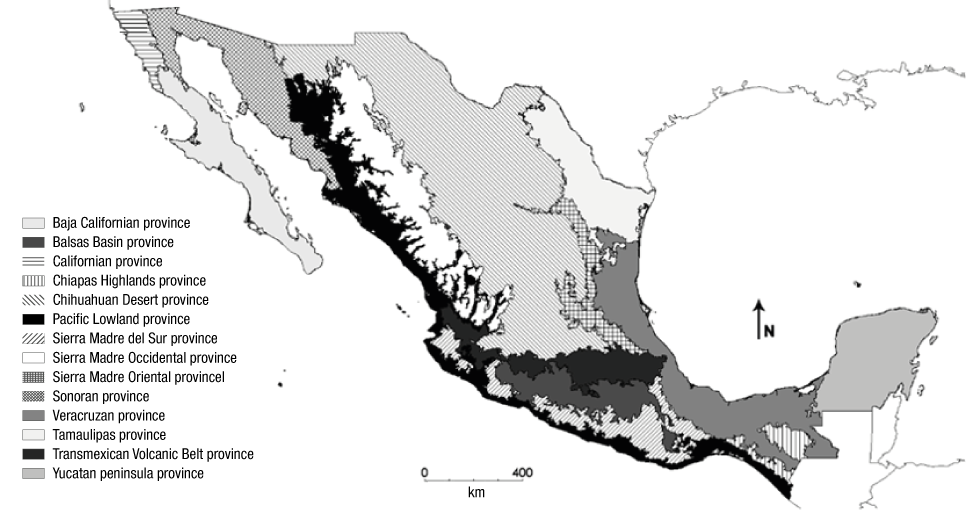
Natural distribution
To model the natural distribution of soursop, the FloraMap 1.03 program was used, which specializes in modelling probabilistic distribution maps based on accession data (Jones & Gladkov, 1999). The program uses eigenvectors of climatic variables (temperature, isothermality and precipitation) and the transformation of precipitation data. To match the values with the temperature scale, the Rain power A transform (Jones & Gladkov, 1999) was used, with a value of 0.1. In addition, six principal components explaining 94.92 % of the total variance were used to generate the maps (Jones & Gladkov, 1999; Jones et al., 2002). Probability maps were calculated without weighting, i.e. all coefficients of the climatic variables evaluated were equal to 1. All FloraMap maps were obtained with a minimum probability of 75 % of locating specimens. To obtain a probabilistic natural distribution map, all the data mentioned above were used.
Eco-climatic characterization
With the use of Floramap 1.03, and considering the same parameters used for the natural distribution, the eco-climatic characterization was carried out through cluster analysis of the accessions using Ward's method (Ward, 1963) and Euclidean distances to identify accessions that grow in similar climates, as a characterization of the different eco-climatic regions where soursop grows. With this, a probabilistic map of each group was generated to determine the different climatic zones where the species is distributed. The climate of each group was characterized according to the Köppen classification modified by García (2004).
Modelling potential and under climate change scenarios
This modelling was carried out with DIVA-GIS package version 7.5 (Hijmans et al., 2012). Distribution models of suitable climate zones for soursop were calculated using the Eco-Crop model, which considers regions that meet the bioclimatic parameters required for the adaptation of each species with a resolution of 2.5 min. The program establishes as excellent regions those that fit practically all the optimal crop growing conditions, and the region classification decreases according to the absence of bioclimatic parameters, up to the area where the species could no longer grow (Hijmans & Graham, 2006; FAO, 2007) (Table 1). In addition, two scenarios were considered. In the first, called current potential zones, actual climate data accumulated over 50 years (1950-2000) were used, taken from the Worldclim (WC) climate database (Hijmans et al., 2005). In the second, named potential future zones, the data were modelled considering a doubling of the atmospheric CO2 concentration to simulate the global climate change scenario, which is used in the CCM3 model to calculate the climate database (Govindasamy et al., 2003).
Both models were compared to locate the most suitable areas for establishing in vivo germplasm banks, mother orchards and evaluation plots for soursop (Hijmans et al., 2001; Hijmans & Graham, 2006), this accordance with the optimal climatic characteristics for its development (FAO, 2007). Only climatic data related to temperature and precipitation were considered in the analyses, and no other factors such as wind or soil due to the complexity of the models; moreover, the variables considered are more significant and allow for better prediction (Jones et al, 2002; Hijmans et al., 2012).
Results
Natural distribution
The general natural distribution of soursop in Mexico showed that the species is distributed with a high percentage of probability in most of the tropical regions of Veracruz and the Yucatán peninsula. With lower probability/Less likely, the species is distributed in the northern, central and some southern points of the Mexican Pacific coast, the Balsas basin region, the southern areas of the Chihuahuan desert and the Sierra Madre Occidental, and the Sierra Madre del Sur and Chiapas highlands region (Figure 2). Most of the soursop's natural range is below the Tropic of Cancer (Figure 2).

Eco-climatic characterization
According to the dendrogram of the cluster analysis (Figure 3), it was found that soursop grows in three different climatic groups: two with a completely tropical climate and one with a temperate climate (Garcia, 2004), designated as Aw1 (intermediate sub-humid tropical with summer rains), Am (humid tropical with summer rains) and C(w0) (sub-humid temperate with summer rains, being the driest for this subtype), for groups 1, 2 and 3, respectively.
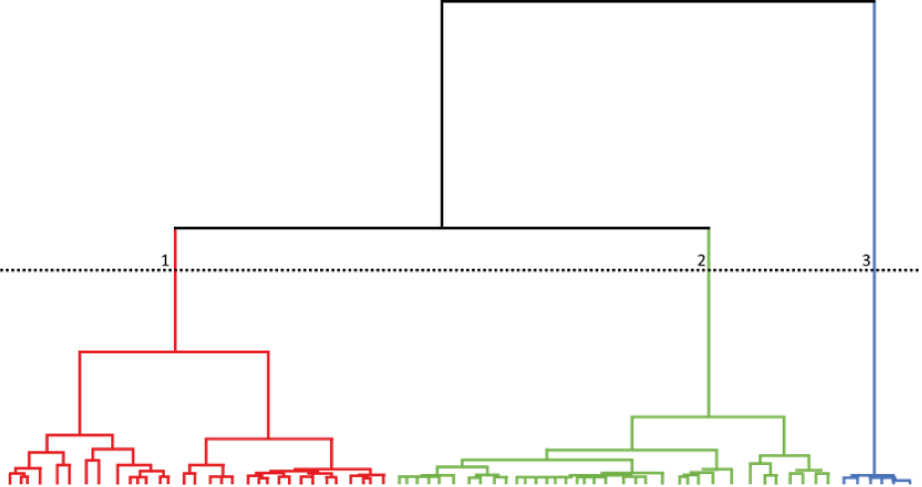
When comparing the climograms (Figure 4), it is evident that group 3 showed lower rainfall and temperature, typical of humid and sub-humid tropical climates. This group showed winter temperatures below 13 °C, which is the minimum with no damage, but did not reach the killing temperature of the species (Table 1). Groups 1 and 2 contrasted only in the distribution of precipitation, but not in its annual amount, as group 1 had drier winters, although both are rainy in summer.
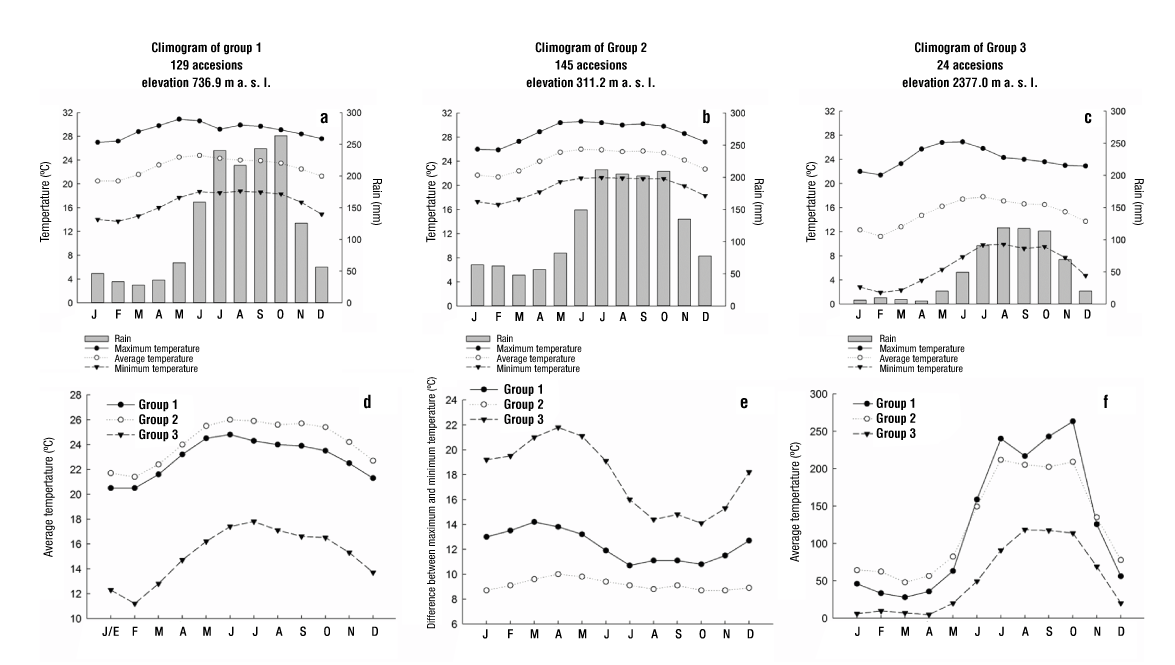
Group 1, which corresponds to climate Aw1, is naturally distributed with greater probability along the edges of the Balsas basin, and in the south, southeast and central north Veracruz region, as well as in the center of the Mexican Pacific coast (Figure 5a), although it also has a good probability in other areas of the Mexican Pacific coast, the Yucatán peninsula and southern Tamaulipas.
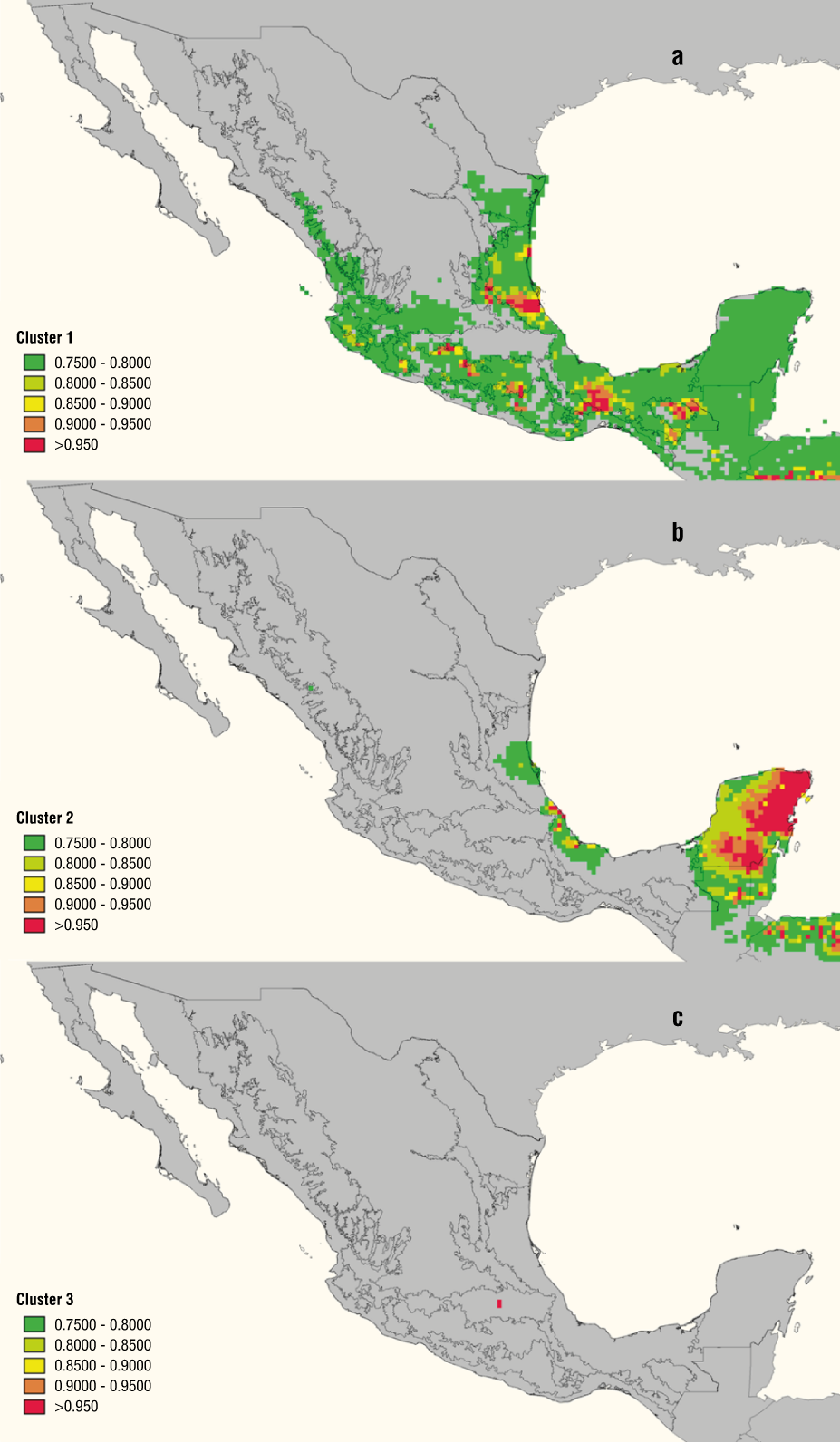
Group 2, which corresponds to climate Am, is distributed only in the north and central south of the Veracruz region and the Yucatán peninsula, within the latter with greater probability in the Caribbean zone (Figure 5b). Group 3, which corresponds to climate C(w0), has an extremely restricted distribution in the east of the Trans-Mexican Volcanic Belt, since it has an atypical climate for soursop (Figure 5c).
Modelling potential and under climate change scenarios
The Eco-Crop model, using the WorldClim climate database, showed that the current areas with excellent climates for soursop cultivation are almost the entire Pacific coast of Mexico and Veracruz, and some areas of the Balsas basin and the Yucatán peninsula. On the other hand, other areas of the Balsas basin and the Yucatán peninsula, as well as the south-southwest of the Chihuahuan desert, west of the Trans-Mexican Volcanic Belt and the Chiapas highlands have more restricted climates (Figure 6a).
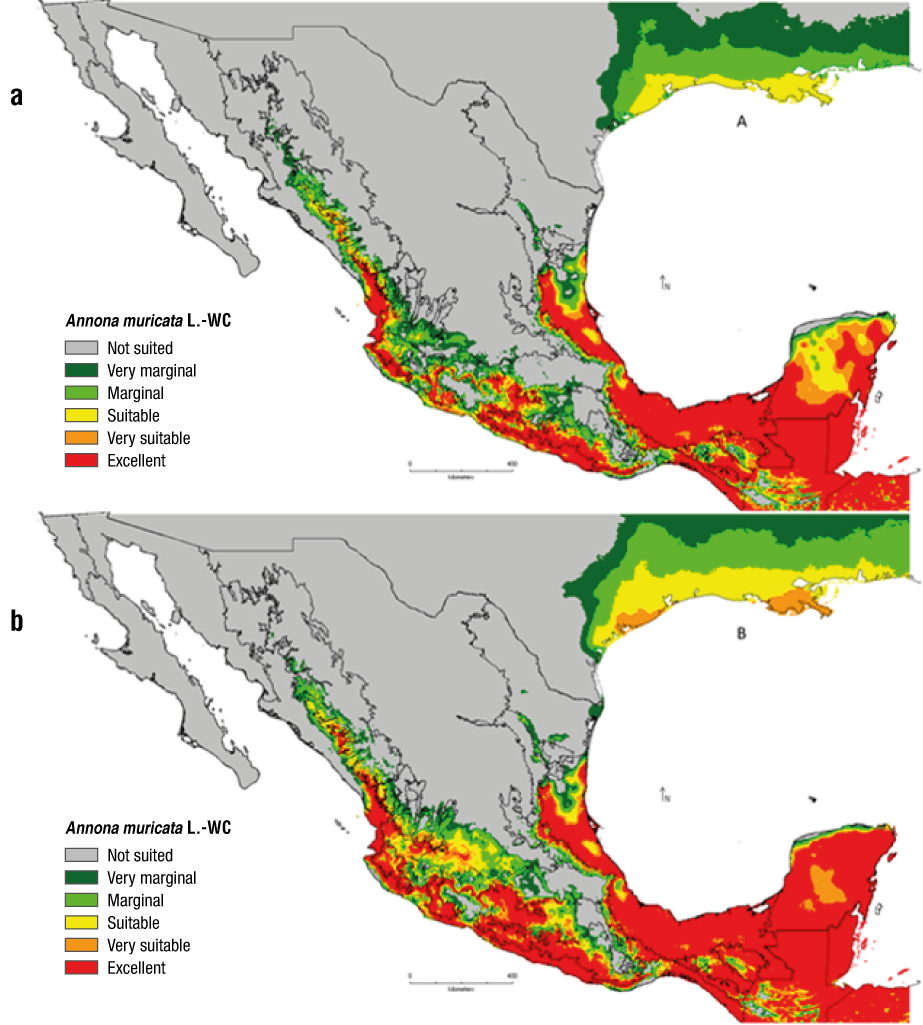
With the same model, but with the CCM3 database - as a global climate change model - it was observed that the Mexican Pacific coast and the Veracruz region maintain, or even expand, the areas with excellent climates for soursop cultivation. Likewise, there is an expansion of areas in the Balsas basin, the Yucatán peninsula, the Chiapas highlands and the southern Chihuahuan desert, the last with some limitations (Figure 6b).
Discussion
The general natural distribution coincided with the conditions reported for soursop, which grows mainly in tropical climates -type A according to the Köppen classification modified by García (2004) - (Chatrou et al., 2012; Segura et al., 2012; Andrés-Agustín & Segura-Ledesma, 2014; Escobedo-López et al., 2019). However, considering the data presented in the present work, the distribution could be extended to some subtropical and even temperate areas. De la Cruz-Chacón et al. (2016) note that there is a high variability of soursop-producing areas in Mexico, which are located in regions with a high probability of finding this species naturally. Other authors point out that most orchards use seeds for soursop propagation, which could explain the high variability of germplasm (Evangelista-Lozano et al., 2003; Terán-Erazo et al., 2019; Villarreal-Fuentes et al., 2020).
On the other hand, the three eco-climatic groups, being contrasting in some of their environmental conditions, indicate that soursop may have developed variants, resulting in different gene pools (Dobzhansky, 1970). This strengthens the hypothesis put forward by de la Cruz-Chacón et al. (2016), who argue that soursop can be considered native to Mexico, not as a center of origin, but as a center of diversification according to Vavilov's (1951) treatises.
Eco-climatic group 3, although it has a very restricted distribution, presents climatic patterns similar to cherimoya (Annona cherimola Mill.). Rodríguez-Núñez et al. (2021) report three eco-climatic groups for this fruit tree: C(m)(w), (A)C(e’) and (A)C(e); i.e. one temperate and two subtropical, more similar to the temperate group. Custard apple is one of the Annonaceae best adapted to temperate climates (Andrés-Agustín & Segura-Ledesma, 2014), contrary to what was reported for soursop, which was considered almost exclusive to tropical climates (Chatrou et al., 2012; Segura et al., 2012; Escobedo-López et al., 2019). Group 3 accessions could be a good source of genes for resistance to chilling injury in the postharvest of soursop, as has been reported for other fruit trees such as guava (Psidium guajava L.), where tropical and temperate gene pools have also been evaluated (Cázares-Sánchez et al., 2010; Mondragón-Jacobo et al., 2010). Additionally, it would be interesting to evaluate the profile of nutraceutical substances reported for soursop (Villarreal-Fuentes et al., 2020; Grijalva-Verdugo et al., 2022), since it has only been studied in fruits from tropical areas (Grijalva-Verdugo et al., 2022).
Modelling of suitable regions for soursop cultivation using Eco-Crop highlights as areas with excellent conditions the current producing areas of the country and the places where ex situ and in vivo germplasm banks have been established (Andrés-Agustín & Segura-Ledesma, 2014; Villarreal-Fuentes et al., 2020; Terán-Erazo et al., 2022). Additionally, global climate change-according to the CCM3 database-will not affect the adaptation of the crop in current areas, which could even be expanded to regions where there are currently climatic constraints.
Conclusions
Three climatic groups were found for soursop cultivation in Mexico, where one of them -which has a restricted distribution - is temperate and had not been previously reported.
The climatic variability of soursop adaptation leads to the inference that to conserve germplasm, genotypes from all three climatic groups need to be represented.
Modelling of suitable growing areas showed that climate change will not affect the current soursop growing regions in Mexico, and even beneficial effects on the adaptation of this species are predicted.
It is recommended to grow soursop in the regions of the Balsas basin and the Yucatán peninsula due to its high adaptation potential, in order to increase the production of this crop in Mexico.

